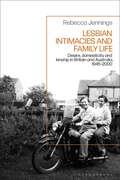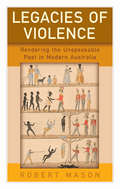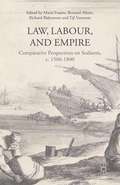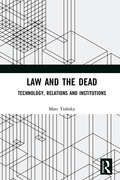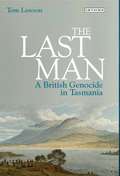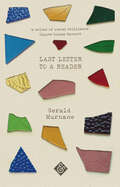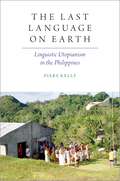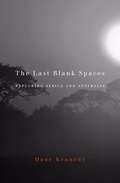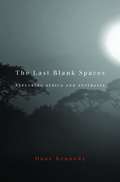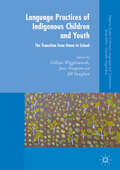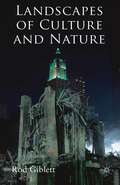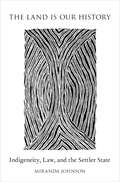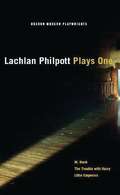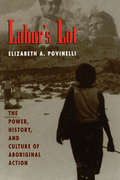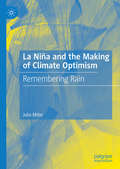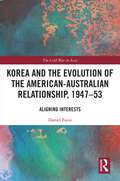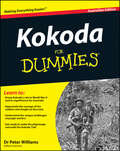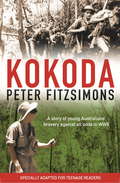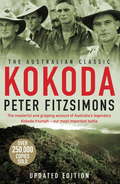- Table View
- List View
Lesbian Intimacies and Family Life: Desire, domesticity and kinship in Britain and Australia, 1945-2000
by Rebecca JenningsFocusing on patterns of intimacy, this book traces the historical roots of parenting practices and familial patterns constructed by lesbians and same-sex attracted women living in Britain and Australia between 1945 and 2000. It foregrounds women's unique lived experiences, as they expressed desire, fell in love, and created families against the backdrop of changing cultural, legal, and medical attitudes to female same-sex desire in the late 20th century.Including almost 100 original oral history interviews conducted by the author, Lesbian Intimacies and Family Life reveals the subjective histories of lesbian intimacy during the period, both highlighting the huge variety in women's experiences, and tracing shifting patterns of relationship and family formation. Combined with analysis of representations of lesbian intimacy in literature, press articles, medical texts, and archival material, the book demonstrates the ways in which changing political and cultural concepts of sexuality impacted on individual and collective attitudes.With a unique transnational perspective, Jennings uncovers how feminist and lesbian networks between Britain and Australia promoted knowledge sharing and helped foster change in the familial practices of each country – such as through the adoption of reproductive technologies and alternate routes into motherhood. Through considering the rise of divorce and challenges to traditional marriage practices in the period, this book highlights how lesbian relationships provided alternative models of interpersonal relations, impacting on broader patterns of sexuality, and helping redefine notions of the family in the modern era.
Legacies of Violence: Rendering the Unspeakable Past in Modern Australia
by Robert MasonWhether in the form of warfare, dispossession, forced migration, or social prejudice, Australia’s sense of nationhood was born from—and continues to be defined by—experiences of violence. Legacies of Violence probes this brutal legacy through case studies that range from the colonial frontier to modern domestic spaces, exploring themes of empathy, isolation, and Australians’ imagined place in the world. Moving beyond the primacy that is typically accorded white accounts of violence, contributors place particular emphasis on the experiences of those perceived to be on the social periphery, repositioning them at the center of Australia’s relationship to global events and debates.
Law, Labour, and Empire: Comparative Perspectives on Seafarers, c. 1500-1800
by Maria FusaroSeafarers were the first workers to inhabit a truly international labour market, a sector of industry which, throughout the early modern period, drove European economic and imperial expansion, technological and scientific development, and cultural and material exchanges around the world. This volume adopts a comparative perspective, presenting current research about maritime labourers across three centuries, in the Mediterranean Sea and the Atlantic and Indian Oceans, to understand how seafarers contributed to legal and economic transformation within Europe and across the world. Focusing on the three related themes of legal systems, labouring conditions, and imperial power, these essays explore the dynamic and reciprocal relationship between seafarers' individual and collective agency, and the social and economic frameworks which structured their lives.
Law and the Dead: Technology, Relations and Institutions
by Marc TrabskyThe governance of the dead in the eighteenth and nineteenth centuries gave rise to a new arrangement of thanato-politics in the West. Legal, medical and bureaucratic institutions developed innovative technologies for managing the dead, maximising their efficacy and exploiting their vitality. Law and the Dead writes a history of their institutional life in the nineteenth and twentieth centuries. With a particular focus on the technologies of the death investigation process, including place-making, the forensic gaze, bureaucratic manuals, record-keeping and radiography, this book examines how the dead came to be incorporated into legal institutions in the modern era. Drawing on the writings of philosophers, historians and legal theorists, it offers tools for thinking through how the dead dwell in law, how their lives persist through the conduct of office, and how coroners assume responsibility for taking care of the dead. This historical and interdisciplinary book offers a provocative challenge to conventional thinking about the sequestration of the dead in the nineteenth and twentieth centuries. It asks the reader to think through and with legal institutions when writing a history of the dead, and to trace the important role assumed by coroners in the governance of the dead. This book will be of interest to scholars working in law, history, sociology and criminology.
Law and the Dead: Technology, Relations and Institutions
by Marc TrabskyThe governance of the dead in the eighteenth and nineteenth centuries gave rise to a new arrangement of thanato-politics in the West. Legal, medical and bureaucratic institutions developed innovative technologies for managing the dead, maximising their efficacy and exploiting their vitality. Law and the Dead writes a history of their institutional life in the nineteenth and twentieth centuries. With a particular focus on the technologies of the death investigation process, including place-making, the forensic gaze, bureaucratic manuals, record-keeping and radiography, this book examines how the dead came to be incorporated into legal institutions in the modern era. Drawing on the writings of philosophers, historians and legal theorists, it offers tools for thinking through how the dead dwell in law, how their lives persist through the conduct of office, and how coroners assume responsibility for taking care of the dead. This historical and interdisciplinary book offers a provocative challenge to conventional thinking about the sequestration of the dead in the nineteenth and twentieth centuries. It asks the reader to think through and with legal institutions when writing a history of the dead, and to trace the important role assumed by coroners in the governance of the dead. This book will be of interest to scholars working in law, history, sociology and criminology.
The Last Man: A British Genocide in Tasmania
by Tom LawsonLittle more than seventy years after the British settled Van Diemen's Land (later Tasmania) in 1803, its indigenous population had been virtually wiped out. Yet this genocide - one of the earliest of the modern era - is virtually forgotten in Britain today. The Last Man is the first book specifically to explore the role of the British government and wider society in the destruction of the Aboriginal Tasmanians. Although the introduction of European diseases undoubtedly contributed to the decline of the indigenous population, Tom Lawson shows that Britain supported what was effectively the ethnic cleansing of Tasmania - particularly in the period of martial law in 1828-1832. He also illustrates the ways in which the destruction of indigenous Tasmanians was reflected in British culture - both at the time and since - and how it came to play a key part in forging particular versions of British imperial identity. The Last Man provides the first comprehensive picture of Britain's role in the destruction of the Tasmanian Aboriginal population.
Last Letter to a Reader
by Gerald MurnaneIn the first days of spring in his eighty-second year, Gerald Murnane – perhaps the greatest living writer of English prose – began a project that would round off his strange career as a novelist. He would read all of his books in turn and prepare a report on each. His original intention was to lodge the reports in two of his legendary filing cabinets: in the Chronological Archive, which documents his life as a whole, and the Literary Archive, which is devoted to everything he has written. As the reports grew, however, they themselves took on the form of a book, a book as beguiling and hallucinatory, in its way, as the works on which they were meant to report. These miniature memoirs or stories lead the reader through the capacious territory Murnane refers to as his mind: they dwell on the circumstances that gave rise to his writing, on images and associations, on Murnane’s own theories of fiction, and then memories of a deeply personal kind. The final essay is, of course, on Last Letter to a Reader itself: it considers the elation and exhilaration that accompany the act of writing, and offers a moving finale to what must surely be Murnane’s last work, as death approaches. ‘Help me, dear one,’ he writes, ‘to endure patiently my going back to my own sort of heaven.’
The Last Language on Earth: Linguistic Utopianism in the Philippines (Oxford Studies in the Anthropology of Language)
by Piers KellyThe Last Language on Earth is an ethnographic history of the disputed Eskayan language, spoken today by an isolated upland community living on the island of Bohol in the southern Philippines. After Eskaya people were first 'discovered' in 1980, visitors described the group as a lost tribe preserving a unique language and writing system. Others argued that the Eskaya were merely members of a utopian rural cult who had invented their own language and script. Rather than adjudicating outsider polemics, this book engages directly with the language itself as well as the direct perspectives of those who use it today. Through written and oral accounts, Eskaya people have represented their language as an ancestral creation derived from a human body. Reinforcing this traditional view, Piers Kelly's linguistic analysis shows how a complex new register was brought into being by fusing new vocabulary onto a modified local grammar. In a synthesis of linguistic, ethnographic, and historical evidence, a picture emerges of a coastal community that fled the ravages of the U.S. invasion of the island in 1901 in order to build a utopian society in the hills. Here they predicted that the world's languages would decline leaving Eskayan as the last language on earth. Marshalling anthropological theories of nationalism, authenticity, and language ideology, along with comparisons to similar events across highland Southeast Asia, Kelly offers a convincing account of this linguistic mystery and also shows its broader relevance to linguistic anthropology. Although the Eskayan situation is unusual, it has the power to illuminate the pivotal role that language plays in the pursuit of identity-building and political resistance.
The Last Language on Earth: Linguistic Utopianism in the Philippines (Oxford Studies in the Anthropology of Language)
by Piers KellyThe Last Language on Earth is an ethnographic history of the disputed Eskayan language, spoken today by an isolated upland community living on the island of Bohol in the southern Philippines. After Eskaya people were first 'discovered' in 1980, visitors described the group as a lost tribe preserving a unique language and writing system. Others argued that the Eskaya were merely members of a utopian rural cult who had invented their own language and script. Rather than adjudicating outsider polemics, this book engages directly with the language itself as well as the direct perspectives of those who use it today. Through written and oral accounts, Eskaya people have represented their language as an ancestral creation derived from a human body. Reinforcing this traditional view, Piers Kelly's linguistic analysis shows how a complex new register was brought into being by fusing new vocabulary onto a modified local grammar. In a synthesis of linguistic, ethnographic, and historical evidence, a picture emerges of a coastal community that fled the ravages of the U.S. invasion of the island in 1901 in order to build a utopian society in the hills. Here they predicted that the world's languages would decline leaving Eskayan as the last language on earth. Marshalling anthropological theories of nationalism, authenticity, and language ideology, along with comparisons to similar events across highland Southeast Asia, Kelly offers a convincing account of this linguistic mystery and also shows its broader relevance to linguistic anthropology. Although the Eskayan situation is unusual, it has the power to illuminate the pivotal role that language plays in the pursuit of identity-building and political resistance.
The Last Blank Spaces: Exploring Africa And Australia
by Dane KennedyThe challenge of opening Africa and Australia to British imperial influence fell to a coterie of proto-professional explorers who sought knowledge, adventure, and fame but often experienced confusion, fear, and failure. The Last Blank Spaces follows the arc of these explorations, from idea to practice, intention to outcome, myth to reality.
The Last Blank Spaces: Exploring Africa And Australia
by Dane KennedyThe challenge of opening Africa and Australia to British imperial influence fell to a coterie of proto-professional explorers who sought knowledge, adventure, and fame but often experienced confusion, fear, and failure. The Last Blank Spaces follows the arc of these explorations, from idea to practice, intention to outcome, myth to reality.
Language Practices of Indigenous Children and Youth: The Transition from Home to School (Palgrave Studies in Minority Languages and Communities)
by Gillian Wigglesworth Jane Simpson Jill VaughanThis book explores the experiences of Indigenous children and young adults around the world as they navigate the formal education system and wider society. Profiling a range of different communities and sociolinguistic contexts, this book examines the language ecologies of their local communities, schools and wider society and the approaches taken by these communities to maintain children’s home languages. The authors examine such complex themes as curriculum, translanguaging, contact languages and language use as cultural practice. In doing so, this edited collection acts as a first step towards developing solutions which address the complexity of the issues facing these children and young people. It will appeal to students and scholars of sociolinguistics, applied linguistics and community development, as well as language professionals including teachers, curriculum developers, language planners and educators.
Landscapes of Culture and Nature
by R. GiblettA bold and exciting exploration of the relationship and interactions between humans, the human landscape and the earth, looking at a diverse range of case studies from the nineteenth-century city to the Asian tsunami and Hurricane Katrina.
LAND IS OUR HISTORY C: Indigeneity, Law, and the Settler State
by Miranda JohnsonThe Land Is Our History tells the story of indigenous legal activism at a critical political and cultural juncture in Australia, Canada, and New Zealand. In the late 1960s, indigenous activists protested assimilation policies and the usurpation of their lands as a new mining boom took off, radically threatening their collective identities. Often excluded from legal recourse in the past, indigenous leaders took their claims to court with remarkable results. For the first time, their distinctive histories were admitted as evidence of their rights. Miranda Johnson examines how indigenous peoples advocated for themselves in courts and commissions of inquiry between the early 1970s to the mid-1990s, chronicling an extraordinary and overlooked history in which virtually disenfranchised peoples forced powerful settler democracies to reckon with their demands. Based on extensive archival research and interviews with leading participants, The Land Is Our History brings to the fore complex and rich discussions among activists, lawyers, anthropologists, judges, and others in the context of legal cases in far-flung communities dealing with rights, history, and identity. The effects of these debates were unexpectedly wide-ranging. By asserting that they were the first peoples of the land, indigenous leaders compelled the powerful settler states that surrounded them to negotiate their rights and status. Fracturing national myths and making new stories of origin necessary, indigenous peoples' claims challenged settler societies to rethink their sense of belonging.
The Land Is Our History: Indigeneity, Law, and the Settler State
by Miranda JohnsonThe Land Is Our History tells the story of indigenous legal activism at a critical political and cultural juncture in Australia, Canada, and New Zealand. In the late 1960s, indigenous activists protested assimilation policies and the usurpation of their lands as a new mining boom took off, radically threatening their collective identities. Often excluded from legal recourse in the past, indigenous leaders took their claims to court with remarkable results. For the first time, their distinctive histories were admitted as evidence of their rights. Miranda Johnson examines how indigenous peoples advocated for themselves in courts and commissions of inquiry between the early 1970s to the mid-1990s, chronicling an extraordinary and overlooked history in which virtually disenfranchised peoples forced powerful settler democracies to reckon with their demands. Based on extensive archival research and interviews with leading participants, The Land Is Our History brings to the fore complex and rich discussions among activists, lawyers, anthropologists, judges, and others in the context of legal cases in far-flung communities dealing with rights, history, and identity. The effects of these debates were unexpectedly wide-ranging. By asserting that they were the first peoples of the land, indigenous leaders compelled the powerful settler states that surrounded them to negotiate their rights and status. Fracturing national myths and making new stories of origin necessary, indigenous peoples' claims challenged settler societies to rethink their sense of belonging.
Lachlan Philpott: Plays One (Oberon Modern Playwrights)
by Lachlan PhilpottThree plays by multi-award-winning Australian writer Lachlan Philpott, including M. Rock, Little Emperors, and The Trouble with Harry.M. Rock is based on a true story about the enduring joys of music, dancing and self-discovery, and charts the fortunes of 18-year-old Tracey and her grandmother Mabel.Little Emperors: ‘Little Emperor Syndrome’ is a term used to describe the behavioural time-bomb created by China’s One Child Policy. Set in both Melbourne and Beijing, and weaving between Mandarin and English, Little Emperors deals with a single family as they attempt to negotiate the troubled waters of their shared history, one that includes a hidden second child, forced separation, and deep wells of regret and shame. The Trouble with Harry: Harry Crawford and his wife Annie seem happy enough. Together they lead quiet, unexceptional lives in the suburbs of 1920s Sydney, working and raising a child. But when Josephine arrives at the door, it sets in train a series of events that will result in an astounding revelation. A disorienting tale of deception and enigma which poses an essential, human question: can we ever really know what lies in the heart and mind of someone else?
Labor's Lot: The Power, History, and Culture of Aboriginal Action
by Elizabeth A. PovinelliHow does an Aboriginal community see itself, its work, and its place on the land? Elizabeth Povinelli goes to the Belyuen community of northern Australia to show how it draws from deep connections between labor, language, and the landscape. Her findings challenge Western notions of "productive labor" and longstanding ideas about the role of culture in subsistence economies. In Labor's Lot, Povinelli shows how everyday activities shape Aboriginal identity and provide cultural meaning. She focuses on the Belyuen women's interactions with the countryside and on Belyuen conflicts with the Australian government over control of local land. Her analysis raises serious questions about the validity of Western theories about labor and culture and their impact on Aboriginal society. Povinelli's focus on women's activities provides an important counterpoint to recent works centering on male roles in hunter-gatherer societies. Her unique "cultural economy" approach overcomes the dichotomy between the two standard approaches to these studies. Labor's Lot will engage anyone interested in indigenous peoples or in the relationship between culture and economy in contemporary social practice.
La Niña and the Making of Climate Optimism: Remembering Rain
by Julia MillerThis book examines the deep connection Australians have with their climate to understand contemporary views on human-induced climate change. It is the first study of the Australian relationship with La Niña and it explains how fundamental this relationship is to the climate change debate both locally and globally. While unease with the Australian environment was a hallmark of early settler relations with a new continent, this book argues that the climate itself quickly became a source of hope and linked to progress. Once observed, weather patterns coalesced into recognizable cycles of wet and dry years and Australians adopted a belief in the certainty of good seasons. It was this optimistic response to climate linked to La Niña that laid the groundwork for this relationship with the Australian environment. This book will appeal to scholars and students of the environmental humanities, history and science as well as anyone concerned about climate change.
Korea and the Evolution of the American-Australian Relationship, 1947–53: Aligning Interests (The Cold War in Asia)
by Daniel FazioFazio examines the significance of the US-Australian Korean engagement, 1947–53, in the evolution of the relationship between the two nations in the formative years of the Cold War. In the aftermath of World War Two, divergent American and Australian strategic and security interests converged and then aligned on the Korean peninsula. Fazio argues that the interactions between key US and Australian officials throughout their Korean engagement were crucial to shaping the nature of the evolving relationship and the making of the alliance between the two nations. The diplomacy of Percy Spender, John Foster Dulles, and James Plimsoll was particularly crucial. He demonstrates that the American evaluation of the geo-strategic significance of Korea was a significant factor in the making of the ANZUS alliance and events in Korea remained central to the evolving US-Australian relationship. Their Korean engagement showed the US and Australia had similar and overlapping, rather than identical interests, and that their relationship was much more nuanced and problematic than commonly perceived. Fazio challenges the Australian mythology on the origins of the ANZUS Treaty and presents a cautionary insight into the limits of Australia’s capacity to influence US policy to benefit its interests. An insightful read for diplomatic historians, providing greater depth to understanding the broader historical context of the trajectory of the US-Australian relationship and alliance since the beginning of the Cold War.
Korea and the Evolution of the American-Australian Relationship, 1947–53: Aligning Interests (The Cold War in Asia)
by Daniel FazioFazio examines the significance of the US-Australian Korean engagement, 1947–53, in the evolution of the relationship between the two nations in the formative years of the Cold War. In the aftermath of World War Two, divergent American and Australian strategic and security interests converged and then aligned on the Korean peninsula. Fazio argues that the interactions between key US and Australian officials throughout their Korean engagement were crucial to shaping the nature of the evolving relationship and the making of the alliance between the two nations. The diplomacy of Percy Spender, John Foster Dulles, and James Plimsoll was particularly crucial. He demonstrates that the American evaluation of the geo-strategic significance of Korea was a significant factor in the making of the ANZUS alliance and events in Korea remained central to the evolving US-Australian relationship. Their Korean engagement showed the US and Australia had similar and overlapping, rather than identical interests, and that their relationship was much more nuanced and problematic than commonly perceived. Fazio challenges the Australian mythology on the origins of the ANZUS Treaty and presents a cautionary insight into the limits of Australia’s capacity to influence US policy to benefit its interests. An insightful read for diplomatic historians, providing greater depth to understanding the broader historical context of the trajectory of the US-Australian relationship and alliance since the beginning of the Cold War.
Kokoda Trail for Dummies
by Peter WilliamsEverything you need to know about the Kokoda Trail and its place in Australian history Interest in the Kokoda Trail is growing rapidly among many Australians, both for its attraction as a hiking destination and for its historical significance. Kokoda For Dummies offers a fast track tool for learning everything you need to know about this unique thoroughfare, in one concise volume. Part history book, part practical guide, Kokoda For Dummies is perfect both for those considering following our Diggers’ footsteps along ‘the track’ or armchair travellers who want to learn about its history. Covering the full history of the Kokoda Trail, from its beginnings as an overland mail route to the fierce battles between the Australians and the Japanese that took place along its length during World War II, the book also includes important information on walking the trail yourself. From the steps you need to take to get ready to what to bring, Kokoda For Dummies is the definitive resource for anyone looking for a comprehensive overview of this significant landmark. Focuses on walking the track as a pilgrimage and a history lesson for history buffs and hiking enthusiasts alike Covers the health and safety concerns involved with walking the track, including a basic Kokoda itinerary Contains eyewitness accounts of the Kokoda battles gleaned from interviews conducted with Australian and Japanese war veterans A comprehensive but accessible history of the Kokoda Trail and its significance to Australia, in one volume.
Kokoda Trail for Dummies
by Peter WilliamsEverything you need to know about the Kokoda Trail and its place in Australian history Interest in the Kokoda Trail is growing rapidly among many Australians, both for its attraction as a hiking destination and for its historical significance. Kokoda For Dummies offers a fast track tool for learning everything you need to know about this unique thoroughfare, in one concise volume. Part history book, part practical guide, Kokoda For Dummies is perfect both for those considering following our Diggers’ footsteps along ‘the track’ or armchair travellers who want to learn about its history. Covering the full history of the Kokoda Trail, from its beginnings as an overland mail route to the fierce battles between the Australians and the Japanese that took place along its length during World War II, the book also includes important information on walking the trail yourself. From the steps you need to take to get ready to what to bring, Kokoda For Dummies is the definitive resource for anyone looking for a comprehensive overview of this significant landmark. Focuses on walking the track as a pilgrimage and a history lesson for history buffs and hiking enthusiasts alike Covers the health and safety concerns involved with walking the track, including a basic Kokoda itinerary Contains eyewitness accounts of the Kokoda battles gleaned from interviews conducted with Australian and Japanese war veterans A comprehensive but accessible history of the Kokoda Trail and its significance to Australia, in one volume.
Kokoda: Younger Readers
by Peter FitzSimonsA story of young Australians' mateship and bravery against all odds in WWIIFor Australians, Kokoda is the iconic battle of World War II, yet few people know just what happened - and just what our troops achieved. In this new edition of his bestselling account of this seminal battle, Peter FitzSimons tells the Kokoda story in a gripping, moving story specially geared for high-school age readers. Conditions on the track were hellish - rain was constant, the terrain close to inhospitable, food and ammunition supplies were practically non-existent and the men constantly battled malaria and dysentery, as well as the Japanese. Kokoda was a defining battle for Australia - a small force of young, ill-equipped Australians engaged a highly experienced and hitherto unstoppable Japanese force on a narrow, precarious jungle track - and defeated them.Prase for the original edition:'an engrossing narrative, beautifully controlled by a master storyteller' The Sydney Morning Herald
Kokoda: 75th Anniversary Edition
by Peter FitzSimons‘an engrossing narrative, beautifully controlled by a master storyteller' Michael McKernan, Sydney Morning Herald The bestselling, acclaimed, authoritative account of one of the most famous battles in Australian military history – now established as a classic. For Australians, Kokoda is the iconic battle of World War II, yet few people know just what happened – and just what our troops achieved. In his bestselling book, Peter FitzSimons tells the Kokoda story in his distinctive gripping style. Conditions on the track were hellish – rain was constant, the terrain close to inhospitable, food and ammunition supplies were practically non-existent and the men constantly battled malaria and dysentery, as well as the Japanese. Kokoda was a defining battle for Australia – a small force of young, ill-equipped Australians engaged a highly experienced and hitherto unstoppable Japanese force on a narrow, precarious jungle track – and defeated them.
